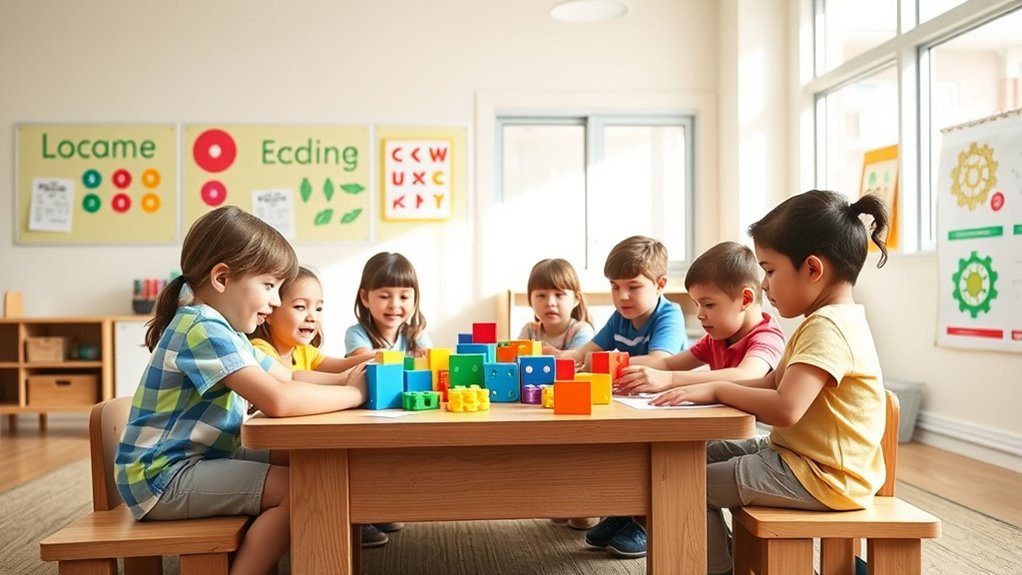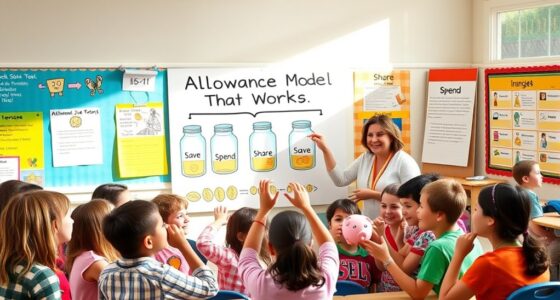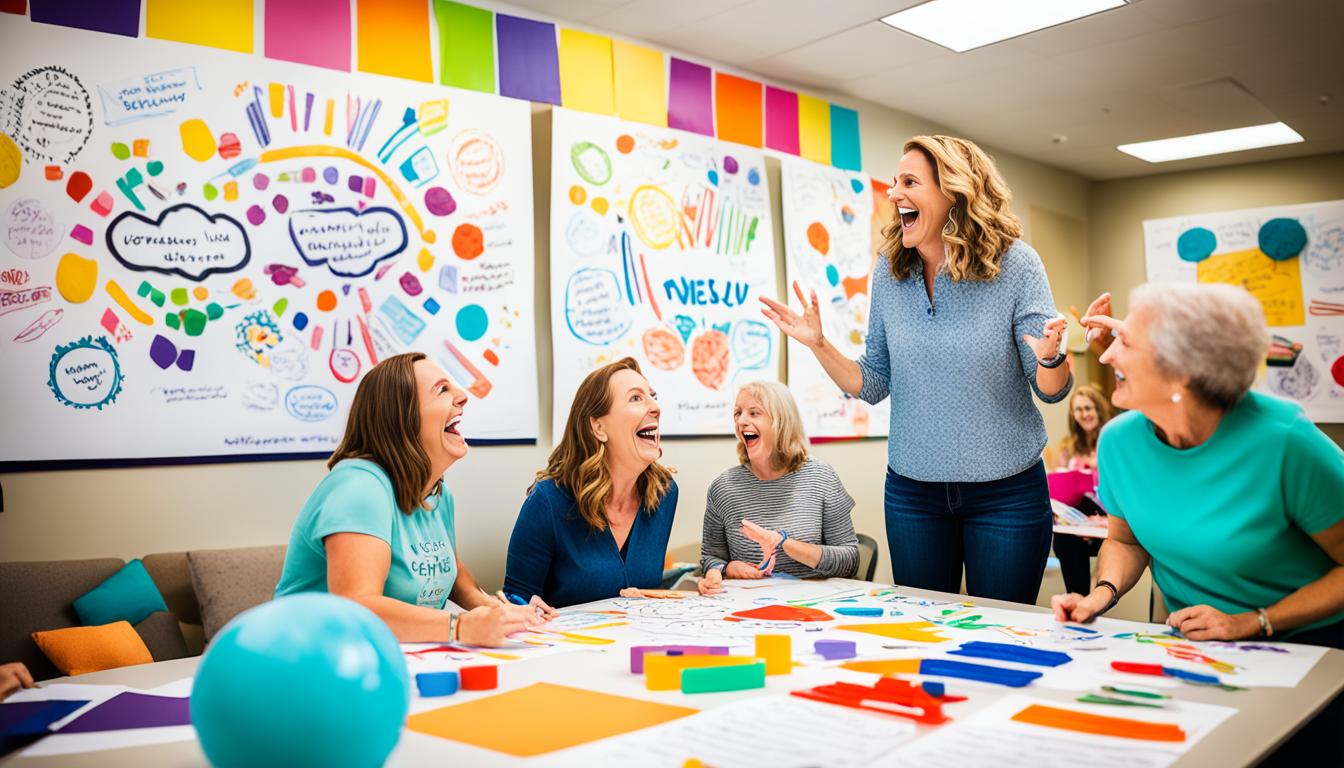To start coding with your preschooler without screens, focus on hands-on activities that develop logical thinking, like obstacle courses with directional commands or story-based role-playing. Use simple robot toys with physical programming blocks to teach commands like move or turn, making coding tangible and fun. These activities spark curiosity and help build foundational skills early. Keep exploring, and you’ll discover effective ways to make coding both engaging and age-appropriate for your child.
Key Takeaways
- Use tangible robot toys with simple controls to introduce basic commands like move, turn, and stop.
- Create hands-on obstacle courses that require children to plan and execute directional steps.
- Incorporate story-based role-playing activities that involve sequencing actions and problem-solving.
- Utilize interactive storytelling apps with coding puzzles to reinforce offline learning through engaging narratives.
- Foster curiosity and logical thinking by encouraging experimentation, questioning, and planning in a playful environment.

Have you ever wondered if preschoolers can start learning coding? It might surprise you, but the answer is yes, and you don’t need to rely on screens to do it. Early coding concepts can be introduced through hands-on activities that develop logical thinking and problem-solving skills, which are foundational for future tech learning. One effective way to start is by using robot toys designed specifically for young children. These toys are simple to operate and often come with intuitive controls or physical programming blocks, allowing preschoolers to understand basic commands like move forward, turn, or stop. Engaging with robot toys makes coding tangible, helping kids grasp cause-and-effect relationships without needing to look at a screen. Plus, many robot toys are durable and safe, making them perfect for energetic preschoolers enthusiastic to explore and experiment.
In addition to robot toys, story apps can be a fantastic, screen-based complement to offline activities. But instead of jumping straight into complex coding platforms, look for story apps that incorporate interactive storytelling with simple coding tasks woven into the narrative. These apps often feature characters guiding children through sequences or puzzles, encouraging them to think logically and plan steps ahead. The beauty of story apps is that they combine storytelling with interactive challenges, making coding feel like a natural extension of play rather than a separate, technical task. They can strengthen understanding of sequencing, patterns, and problem-solving—all essential skills in programming—while still being fun and engaging.
The key to introducing preschoolers to coding without screens is to focus on activities that foster curiosity and logical thinking. For instance, you might set up obstacle courses that require children to give simple directional commands or organize story-based role-playing where kids act out sequences. These activities mimic basic coding logic by encouraging children to analyze a problem, develop a plan, and execute it. Incorporating robot toys into these scenarios makes the experience more interactive and concrete, while story apps can serve as a gentle digital bridge, reinforcing the concepts learned offline. Additionally, understanding the importance of Jeep Tuning principles like precision and step-by-step adjustments can inspire creative ways to teach sequencing and planning in early coding activities.
Ultimately, starting early with hands-on activities and interactive stories prepares preschoolers for more advanced coding later on. It’s about creating a playful environment where they can experiment, ask questions, and learn foundational skills naturally. You don’t have to wait until they’re older or rely solely on screens—by combining tactile toys and story apps, you set the stage for a lifelong interest in coding that begins with simple, engaging experiences tailored to their developmental level.
Frequently Asked Questions
What Are the Best Age-Appropriate Coding Activities for Preschoolers?
You can introduce preschoolers to coding through fun, age-appropriate activities like creating robot stories, where they imagine and tell stories involving robots, fostering creativity and sequencing skills. Tactile puzzles also help develop problem-solving and logical thinking. These activities engage young children actively without screens, making learning playful and interactive. Use simple commands and storytelling to build a foundation for coding concepts, ensuring the activities are both educational and enjoyable.
How Can Parents Encourage Interest in Coding Without Screens?
Did you know that 85% of brain growth happens before age five? You can spark your child’s interest in coding through tangible play and storytelling techniques, making learning fun and interactive. Encourage them to build with blocks, create stories, or solve puzzles that develop problem-solving skills. These activities foster curiosity and critical thinking, laying a strong foundation for future coding skills—all without screens.
Are There Any Risks Associated With Early Coding Exposure?
You might worry about risks like increased screen dependence or early frustration when exposing your preschooler to coding. While it’s great to foster curiosity, too much screen time can lead to dependency and hinder social skills. To avoid this, focus on hands-on, screen-free activities that build problem-solving skills and patience. Setting clear boundaries and providing engaging, tactile experiences helps your child develop a healthy interest in coding without the drawbacks.
What Skills Do Preschoolers Develop Through Coding Activities?
You’ll notice preschoolers develop essential skills through coding activities, such as problem-solving skills and creativity development. When they engage with coding, they learn to think critically, troubleshoot issues, and find solutions. Plus, they get to explore their imagination and create new ideas. These activities help build a strong foundation for future learning, encouraging curiosity and innovation early on. It’s a fun way to foster growth and cognitive development in young children.
How Can Educators Integrate Coding Into Preschool Curricula Effectively?
Think of your curriculum as a garden where robotic storytelling and unplugged problem solving are seeds waiting to sprout. To integrate coding effectively, you can embed these activities into daily routines, encouraging hands-on exploration and creative thinking. Use storytelling to make concepts lively, and challenge children with puzzles that boost logical skills. This approach nurtures curiosity and problem-solving, making coding a natural, engaging part of their learning adventure.
Conclusion
So, step into the world of simple, screen-free coding with confidence. By creating creative challenges, cultivating curiosity, and connecting over coding concepts, you’ll craft a fun-filled foundation for your preschooler’s future. Remember, patience and play are powerful tools—practice, persist, and praise every tiny triumph. With these steps, you’ll turn tiny tots into tech-savvy trailblazers, all while keeping their curiosity captivated and their creativity cultivated!










